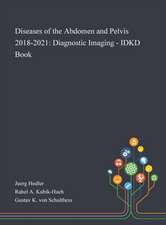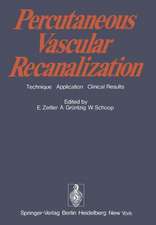Laboratory Biorisk Management: Biosafety and Biosecurity
Editat de Reynolds M. Salerno, Jennifer Gaudiosoen Limba Engleză Hardback – 8 mai 2015
Setting the stage for a substantively different approach for managing the risks of working with biological agents in laboratories, Laboratory Biorisk Management: Biosafety and Biosecurity introduces the concept of biorisk management—a new paradigm that encompasses both laboratory biosafety and biosecurity. The book also provides laboratory managers and directors with the information and technical tools needed for its implementation.
The basis for this new paradigm is a three-pronged, multi-disciplinary model of assessment, mitigation, and performance (the AMP model). The application of the methodologies, criteria, and guidance outlined in the book helps to reduce the risk of laboratories becoming the sources of infectious disease outbreaks.
This is a valuable resource for those seeking to embrace and implement biorisk management systems in their facilities and operations, including the biological research, clinical diagnostic, and production/manufacturing communities.
| Toate formatele și edițiile | Preț | Express |
|---|---|---|
| Paperback (1) | 466.07 lei 6-8 săpt. | |
| CRC Press – 30 mar 2021 | 466.07 lei 6-8 săpt. | |
| Hardback (1) | 988.16 lei 6-8 săpt. | |
| CRC Press – 8 mai 2015 | 988.16 lei 6-8 săpt. |
Preț: 988.16 lei
Preț vechi: 1367.29 lei
-28% Nou
Puncte Express: 1482
Preț estimativ în valută:
189.08€ • 198.13$ • 156.31£
189.08€ • 198.13$ • 156.31£
Carte tipărită la comandă
Livrare economică 12-26 aprilie
Preluare comenzi: 021 569.72.76
Specificații
ISBN-13: 9781466593640
ISBN-10: 1466593644
Pagini: 264
Ilustrații: 24 black & white illustrations, 16 black & white tables
Dimensiuni: 156 x 234 x 20 mm
Greutate: 0.52 kg
Ediția:1
Editura: CRC Press
Colecția CRC Press
ISBN-10: 1466593644
Pagini: 264
Ilustrații: 24 black & white illustrations, 16 black & white tables
Dimensiuni: 156 x 234 x 20 mm
Greutate: 0.52 kg
Ediția:1
Editura: CRC Press
Colecția CRC Press
Public țintă
Professional Practice & Development and Professional ReferenceCuprins
Introduction: The Case for Biorisk Management. The AMP Model. Risk Assessment. Facility Design and Controls. Rethinking Mitigation Measures. Biorisk Management Training. Operations and Maintenance Concepts. Evaluating Biorisk Management Performance. Communication for Biorisk Management. Three Recent Case Studies: The Role of Biorisk Management. Future Development of Biorisk Management: Challenges and Opportunities.
Notă biografică
Edited by
Reynolds M. Salerno is the senior manager for Cooperative Threat Reduction Programs at Sandia National Laboratories in Albuquerque, New Mexico. These programs enhance security by reducing biological, chemical, and nuclear threats worldwide. Reynolds M. Salerno received his PhD from Yale University. Recognized as a leading expert on laboratory biosecurity, Dr. Salerno and his Sandia team have worked extensively in laboratory biosafety, biosecurity, biocontainment, and infectious disease diagnostics and control internationally. As a technical advisor to the World Health Organization (WHO), he was a member of its international team which inspected the Maximum Containment (smallpox) Laboratory at the State Research Center of Virology and Biotechnology VECTOR in Koltsovo, Russia. He recently held the position of vice chairman of the board of directors of the International Federation of Biosafety Associations.
Jennifer Gaudioso leads the International Biological Threat Reduction and International Chemical Threat Reduction programs at Sandia National Laboratories in Albuquerque, New Mexico. These programs enhance US and international security by promoting safe, secure, and responsible use of dangerous biological and chemical agents. The team currently consults in more than 40 countries specifically on biosecurity and chemical security issues. Jennifer Gaudioso earned her PhD in chemistry from Cornell University. Dr. Gaudioso and her Sandia team work with international partners, such as the World Health Organization and the International Federation of Biosafety Associations. Dr. Gaudioso is the author of numerous journal articles and has presented her research at national and international meetings.
Reynolds M. Salerno is the senior manager for Cooperative Threat Reduction Programs at Sandia National Laboratories in Albuquerque, New Mexico. These programs enhance security by reducing biological, chemical, and nuclear threats worldwide. Reynolds M. Salerno received his PhD from Yale University. Recognized as a leading expert on laboratory biosecurity, Dr. Salerno and his Sandia team have worked extensively in laboratory biosafety, biosecurity, biocontainment, and infectious disease diagnostics and control internationally. As a technical advisor to the World Health Organization (WHO), he was a member of its international team which inspected the Maximum Containment (smallpox) Laboratory at the State Research Center of Virology and Biotechnology VECTOR in Koltsovo, Russia. He recently held the position of vice chairman of the board of directors of the International Federation of Biosafety Associations.
Jennifer Gaudioso leads the International Biological Threat Reduction and International Chemical Threat Reduction programs at Sandia National Laboratories in Albuquerque, New Mexico. These programs enhance US and international security by promoting safe, secure, and responsible use of dangerous biological and chemical agents. The team currently consults in more than 40 countries specifically on biosecurity and chemical security issues. Jennifer Gaudioso earned her PhD in chemistry from Cornell University. Dr. Gaudioso and her Sandia team work with international partners, such as the World Health Organization and the International Federation of Biosafety Associations. Dr. Gaudioso is the author of numerous journal articles and has presented her research at national and international meetings.
Recenzii
"Wow—what an eye-opening read on the necessity of biosafety risk management and how to successfully implement it and monitor its effectiveness. This is a great addition for any laboratory—clinical, research, other—working with any biological agent that has disproportionately hazardous adverse health effects."
—Valerie L. Ng, PhD MD, Alameda County Medical Center/Highland Hospital, writing in Doody’s Review Service
—Valerie L. Ng, PhD MD, Alameda County Medical Center/Highland Hospital, writing in Doody’s Review Service
Descriere
Setting the stage for a substantively different approach for managing the risks of working with biological agents in laboratories, this book defines biorisk management and explains how to implement it. The basis for this new paradigm is a three-pronged, multidisciplinary model of assessment, mitigation, and performance (the AMP model). The application of the methodologies, criteria, and guidance outlined in this book will reduce the risk of laboratories becoming the sources of infectious disease outbreaks. It will also significantly improve the safety and security of laboratories that work with infectious diseases.






























